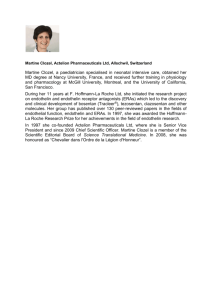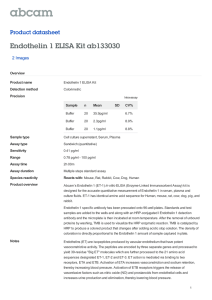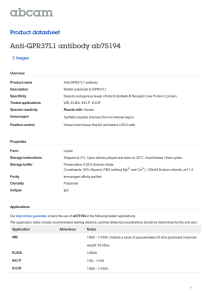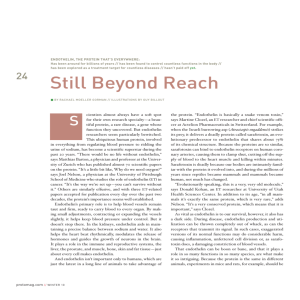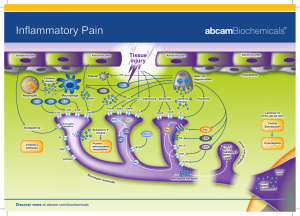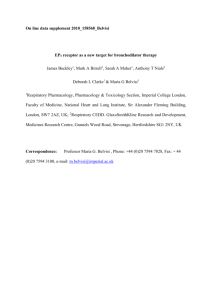Document 13309444
advertisement
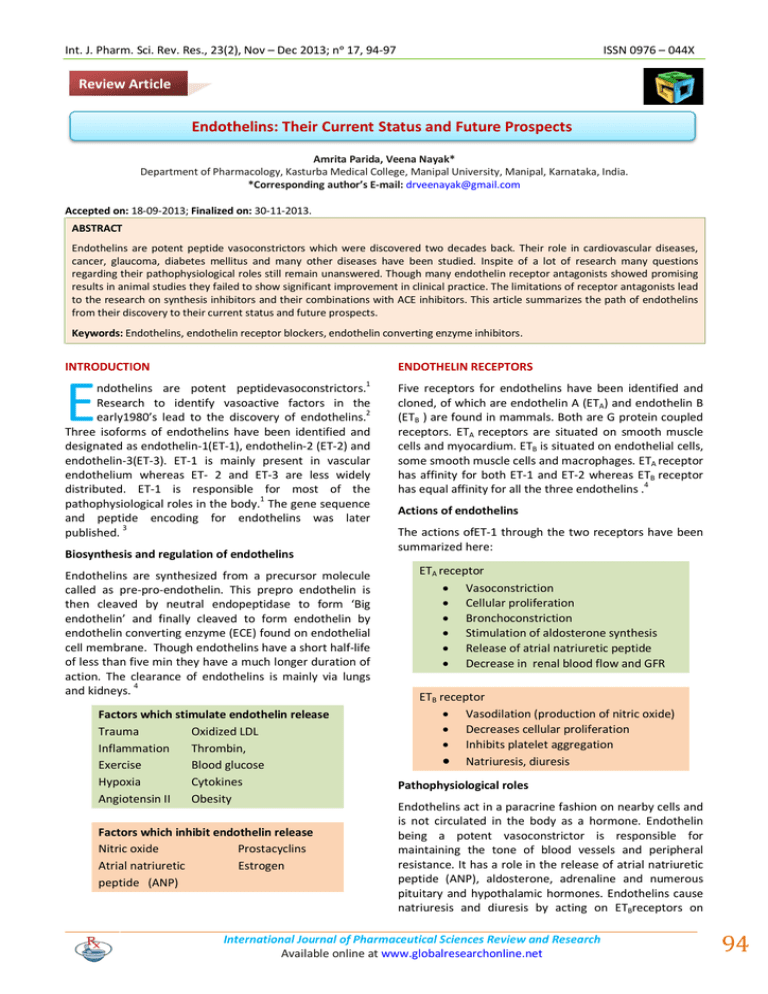
Int. J. Pharm. Sci. Rev. Res., 23(2), Nov – Dec 2013; nᵒ 17, 94-97 ISSN 0976 – 044X Review Article Endothelins: Their Current Status and Future Prospects Amrita Parida, Veena Nayak* Department of Pharmacology, Kasturba Medical College, Manipal University, Manipal, Karnataka, India. *Corresponding author’s E-mail: drveenayak@gmail.com Accepted on: 18-09-2013; Finalized on: 30-11-2013. ABSTRACT Endothelins are potent peptide vasoconstrictors which were discovered two decades back. Their role in cardiovascular diseases, cancer, glaucoma, diabetes mellitus and many other diseases have been studied. Inspite of a lot of research many questions regarding their pathophysiological roles still remain unanswered. Though many endothelin receptor antagonists showed promising results in animal studies they failed to show significant improvement in clinical practice. The limitations of receptor antagonists lead to the research on synthesis inhibitors and their combinations with ACE inhibitors. This article summarizes the path of endothelins from their discovery to their current status and future prospects. Keywords: Endothelins, endothelin receptor blockers, endothelin converting enzyme inhibitors. INTRODUCTION ENDOTHELIN RECEPTORS E 1 ndothelins are potent peptidevasoconstrictors. Research to identify vasoactive factors in the early1980’s lead to the discovery of endothelins.2 Three isoforms of endothelins have been identified and designated as endothelin-1(ET-1), endothelin-2 (ET-2) and endothelin-3(ET-3). ET-1 is mainly present in vascular endothelium whereas ET- 2 and ET-3 are less widely distributed. ET-1 is responsible for most of the pathophysiological roles in the body.1 The gene sequence and peptide encoding for endothelins was later published. 3 Biosynthesis and regulation of endothelins Endothelins are synthesized from a precursor molecule called as pre-pro-endothelin. This prepro endothelin is then cleaved by neutral endopeptidase to form ‘Big endothelin’ and finally cleaved to form endothelin by endothelin converting enzyme (ECE) found on endothelial cell membrane. Though endothelins have a short half-life of less than five min they have a much longer duration of action. The clearance of endothelins is mainly via lungs and kidneys. 4 Factors which stimulate endothelin release Trauma Oxidized LDL Inflammation Thrombin, Exercise Blood glucose Hypoxia Cytokines Angiotensin II Obesity Factors which inhibit endothelin release Nitric oxide Prostacyclins Atrial natriuretic Estrogen peptide (ANP) Five receptors for endothelins have been identified and cloned, of which are endothelin A (ETA) and endothelin B (ETB ) are found in mammals. Both are G protein coupled receptors. ETA receptors are situated on smooth muscle cells and myocardium. ETB is situated on endothelial cells, some smooth muscle cells and macrophages. ETA receptor has affinity for both ET-1 and ET-2 whereas ETB receptor has equal affinity for all the three endothelins .4 Actions of endothelins The actions ofET-1 through the two receptors have been summarized here: ETA receptor Vasoconstriction Cellular proliferation Bronchoconstriction Stimulation of aldosterone synthesis Release of atrial natriuretic peptide Decrease in renal blood flow and GFR ETB receptor Vasodilation (production of nitric oxide) Decreases cellular proliferation Inhibits platelet aggregation Natriuresis, diuresis Pathophysiological roles Endothelins act in a paracrine fashion on nearby cells and is not circulated in the body as a hormone. Endothelin being a potent vasoconstrictor is responsible for maintaining the tone of blood vessels and peripheral resistance. It has a role in the release of atrial natriuretic peptide (ANP), aldosterone, adrenaline and numerous pituitary and hypothalamic hormones. Endothelins cause natriuresis and diuresis by acting on ETBreceptors on International Journal of Pharmaceutical Sciences Review and Research Available online at www.globalresearchonline.net 94 Int. J. Pharm. Sci. Rev. Res., 23(2), Nov – Dec 2013; nᵒ 17, 94-97 tubular cells of kidney. Endothelins also have a significant role in the development of cardiorespiratory system and craniofacial musculature in the fetus .1 Endothelins stimulate production of cytokines and growth factors like vascular endothelium derived growth factor, basic fibroblast growth factor, tumor growth factor–β and platelet derived growth factor. 5 Since endothelins cause vasoconstriction and mitogenic effects, they have been implicated in myocardial fibrosis, atherosclerosis, congestive cardiac failure, hypertension, myocardial infarction, cerebral hemorrhage, stroke, pulmonary arterial hypertension, renal failure. In addition, hypercholesterolemia can induce endothelial dysfunction which can elevate endothelin levels. Endothelins in turn stimulate various growth factors and promotes neutrophil and platelet adhesion, thereby promoting plaque growth and coronary thrombosis.5 Retention of sodium and water due to stimulation of ANP and aldosterone production by endothelins and their reversal by ETA antagonists have confirmed their role in congestive cardiac failure. 6 Endothelins have also been implicated in restenosis after percutaneous coronary angioplasties or stent implantation.7 By inducing some structural changes; endothelins have been suggested to have a role in bronchial asthma and chronic obstructive pulmonary disease.7Endothelins are being studied as a marker of vascular disease in patients with diabetes mellitus. Recent studies suggest that proteinuria in diabetes mellitus is linked to endothelin activation. 8 Endothelins also play a role in adipogenesis and lipolysis. Hence blockade of endothelins may have a potential in the treatment of obesity and various cardiovascular diseases associated with obesity.9 By causing contraction of trabecular meshwork and decreasing the drainage of aqueous humor endothelins cause increase in intraocular pressure. They also decrease blood flow to retina and are responsible for retinal degeneration in glaucoma. Elevated levels of endothelins in aqueous humor have confirmed their role in 7 glaucoma. The mitogenic and antiapoptotic effects along with their ability to promote angiogenesis have shown to be responsible for their tumor growth promoting actions in malignancies and metastases. Elevated levels of ET-1 have been detected in patients with hepatocellular, gastric, prostate and metastatic cancers. 10 Endothelin receptor (ETA) antagonists increased capillary blood flow, decreased capillary permeability and leucocyte infiltration in patients with acute pancreatitis, 7 suggesting a role for endothelins in acute pancreatitis. Drugs acting on endothelin axis ECE inhibitors ISSN 0976 – 044X artery disease, CHF etc. However, inspite of inhibiting the synthesis of endothelins by an ECE inhibitor, studies demonstrated the presence of endothelins, which suggested the presence of alternate pathways for 11 endothelin synthesis. Dual neprilysin and ECE inhibition Neprilysin, a neutral endopeptidase (NEP) degrades atrial natrituretic peptide (ANP). ANP is a vasodilator which antagonizes renin angiotensin system, sympathetic system and release of ET-1. Therefore, inhibition of NEP would be beneficial in retaining ANP levels and thereby improve symptoms of CHF. Dual inhibition of NEP and ECE were found to i. Block the proinflammatory and profibrotic effects of ET-1 ii. Increase the concentration of natriuretic peptides iii. Have vasodilatory, antihypertrophic and antifibrotic effects. iv. The natriuretic action of neprilysin inhibition can block the sodium water retention caused by nonselective blockade of ET receptors.11 Triple inhibitor of ACE – NEP- ECE Studies with triple inhibitors have shown to improve congestive heart failure symptoms more effectively than with ACE inhibitors alone or dual NEP-ECE inhibitors. The triple inhibitor reduced the systemic arterial pressure, cardiac remodeling and improved left ventricular function significantly in animal studies. The limitation of ACE inhibitors is that they decrease ANP production thereby decreasing vasodilation, lusiotropic, diuretic actions of ANP. Hence combining with a NEP inhibitor to increase ANP levels would improve cardiac hemodynamics and increase natriuresis and diuresis. The rationale of combining an ECE inhibitor with NEP inhibitor has been explained above. Hence, this triple combination, definitely would be a new modality to manage CHF.12 Endothelin converting enzyme (ECE) is a key enzyme involved in the conversion of Big ET to ET-1. Inhibitors of ECE were screened for various diseases like coronary International Journal of Pharmaceutical Sciences Review and Research Available online at www.globalresearchonline.net 95 Int. J. Pharm. Sci. Rev. Res., 23(2), Nov – Dec 2013; nᵒ 17, 94-97 Endothelin receptor antagonists Dual ETA and ETB receptor antagonists Bosentan Tezosentan Enrasentan Clazosentan Macitentan Selective ET A receptor antagonist Sitaxsentan Ambrisentan Darusentan Atrasentan No clear uses of ETB antagonist have been defined. Bosentan: It is anorally effective non peptide which is a dual antagonist. It was approved in 2002 for pulmonary arterial hypertension (PAH) at a dose of 62.5 mg twice daily for 4 weeks and maintenance dose of 125 mg twice daily. Bosentan showed improvement in systemic and pulmonary hemodynamic improvement in symptomatic CHF patients. It also improved digital ulcers in systemic sclerosis. It causesanaemia, headache, peripheral oedema, nasal congestion and hepatotoxicity. It is a teratogenic drug. Several long-term clinical trials have now established the efficacy of oral bosentan in reducing symptoms and improving mortality in PPAH. Given the risk of serious liver injury, liver aminotransferases should be monitored monthly.13 Bosentan has also shown to improve exercise capacity and hemodynamics in patients with Eisenmenger syndrome .14 Sitaxsentan: A selective ETA receptor antagonist with negligible inhibition of the beneficial effects of ETB. Its efficacy same as bosentan and has an advantage of once daily dosing. In 2010, Pfizer voluntarily removed sitaxentan from the market due to concerns about liver toxicity. Sitaxentan and bosentan belong to sulphonamide – derived ET receptor antagonist, which explains their 15 potential to cause hepatotoxicity. Ambrisentan: It is an ETA selective antagonist. It was approved in 2007 for the treatment of pulmonary arterial hypertension to be used once daily orally at a dose of 2.5 to 10 mg/day. It is less hepatotoxic and has fewer drug interactions. 16 Clazosentan: This is a dual antagonist. It was tried for vasospasm related morbidity in subarachnoid haemorrhage (SAH). There were no significant results compared to placebo.17 Tezosentan and Enrasentan: They are non-selective antagonists. Both were tried for heart failurebut failed to show any significant improvement. 18, 19 Darusentan: A selective ETA antagonist found to be effective in mild to moderate hypertension and resistant ISSN 0976 – 044X systolic arterial hypertension. It was tried for patients with CHF where it showed an improvement in symptoms but higher doses were associated with more side effects like headache and exacerbation of heart failure. Its other 20 side effects include flushing and peripheral oedema. Macitentan: This is a dual antagonist with higher efficacy, lesser adverse effects and drug interactions. It has completed phase III trials in 2012 for PAH treatment and has been tried for ischemic digital ulcers in systemic 21 sclerosis and recurrent glioblastomas. Atrasentan: It is selective ETA antagonist. It was tried forcarcinoma of prostate where it failed to improve 22 survival in comparison to docetaxel. CONCLUSION Endothelin receptor antagonists have a potential of providing treatment to a variety of diseases. Though endothelin receptor antagonists have undergone research for more than two decades, knowledge about this class of drugs is still far from complete. Many endothelin receptor antagonists are still in the pipeline and warrant further clinical research in various diseases. REFERENCES 1. Benigni A, Remuzzi G, Endothelin antagonists, The Lancet 353, 1999, 133-38. 2. Barton M, Yanagisawa M, Endothelins: 20 years from discovery to therapy, Can J PhysiolPharmacol, 86, 2008, 485-498. 3. Yanagisawa M, Kurihara H, Kimura S, Kimura s, Tomobe Y, Kobayashi M, Mitsui Y, Yazaki Y, Goto K, Masaki T, A novel potent vasoconstrictor peptide produced by vascular endothelial cells, Nature, 332, 1988, 411–415. 4. Luscher TF, Barton M, Endothelins and Endothelin Receptor Antagonists: Therapeutic Considerations for a Novel Class of Cardiovascular Drugs, Circulation, 102, 2000, 2434-2440. 5. Rich S, McLaughlin VV, Endothelin receptor blockers in cardiovascular disease, Circulation, 108, 2003, 2184-2190. 6. Wada A, Tsutamoto T, Fukai D, Ohnishi M, Maeda K,Hisanaga T, Maeda Y, Matsuda Y, Kinoshita M,Comparison of the Effects of Selective Endothelin ETA and ETBReceptor Antagonists in Congestive Heart Failure, JACC,30(5), 1997, 1385–92. 7. Kirchengast M, Luz M, Endothelin receptor antagoinsts : clinical realities and future directions, J Cardiovasc Pharmacol, 45, 2005,182-191. 8. Zanatta CM, Gerchman F, Burttet L, Nabinger G, JacquisSilva MC, Canani LH, Gross JL, Endothelin -1 levels and albuminuria in patients with type 2 diabetes mellitus, Diabetes Res ClinPract, 80, 2008, 299-304. 9. Bhattacharya I, Ullrich A, Endothelin -1 inhibits adipogenisis: role of phosphorylation of Akt and ERK1/2, FEBS Lett580, 2006, 5765-5771. 10. Grant K, Loizidou M, Taylor I,Endothelin-1: a multifunctional molecule in cancer, British journal of cancer, 88, 2003, 163-166. International Journal of Pharmaceutical Sciences Review and Research Available online at www.globalresearchonline.net 96 Int. J. Pharm. Sci. Rev. Res., 23(2), Nov – Dec 2013; nᵒ 17, 94-97 11. Laurent S, Schlaich M, Esler M,Hypertension: New drugs, procedures, and devices for hypertension, Lancet, 380, 2012, 591–600. 12. Mellin V, Jeng AY, Monteil C, Renet S, Henry JP, Thuillez C, Mulder P, Triple ACE-ECE-NEP Inhibition in Heart Failure: AComparison With ACE and Dual ECE-NEP Inhibition, J CardiovascPharmacol, 46, 2005, 390–397. 13. Channick RN, Simonneau G, Sitbon O, Robbins IM, Frost A, Tapson VF, Badesch BD, Roux S, Rainisio M, Bodin F, Rubin LJ,Effects of the dual endothelin-receptor antagonist bosentan in patients with pulmonary hypertension: a randomised placebo controlled study, The Lancet, 358, 2001, 1119-23. 14. Galiè N, Beghetti M, Gatzoulis MA, Granton J, Berger RMF, Lauer A, Chiossi E , Landzberget M, Bosentan Therapy in Patients With Eisenmenger Syndrome: A Multicenter, Double-Blind, Randomized, Placebo-Controlled Study, Circulation, 114, 2006, 48-54. 15. Pfizer. Pfizer Stops Clinical Trials of Thelin and Initiates Voluntary Product Withdrawal in the Interest of Patient Safety. December 10, 2010. Available at: http://pfizer.mediaroom.com/index.php?s=5149&item=22 387. Accessed September 2013. 16. Frampton JE, Ambrisentan, Am J Cardiovasc Drugs, 11(4), 2011,215-26. 17. Macdonald RL, Higashida RT, Keller E, Mayer SA, Molyneux A, Raabe A, Vajkoczy P, Wanke I, Bach D, Frey A, Nowbakht P, Roux S, Kassell N, Randomized trial of clazosentan in patients with aneurysmal subarachnoid hemorrhage ISSN 0976 – 044X undergoing endovascular coiling. Stroke, 43(6), 2012, 14639. 18. Teerlink JR, McMurray JJ, Bourge RC, Cleland JG, Cotter G, Jondeau G,Krum H, Metra M, O'Connor CM, Parker JD, Torre-Amione G, Van Veldhuisen DJ, Frey A, Rainisio M, Kobrin I; VERITAS Investigators, Tezosentan in patients with acute heart failure: design of the Value of Endothelin Receptor Inhibition with Tezosentan in Acute heart failure Study (VERITAS), Am Heart J, 150(1),2005, 46-53. 19. Cosenzi A.Enrasentan, an antagonist of endothelin receptors, Cardiovasc Drug Rev,21, 2003, 1-16. 20. Liang F, Glascock CB, Schafer DL, Sandoval J, Cable L, Melvin L Jr, Hartman JC, Pitts KR, Darusentan is a potent inhibitor of endothelin signaling and function in both large and small arteries, Can J PhysiolPharmacol, 88(8),2010, 840-9. 21. Pulido T, Adzerikho I, Channick RN, Delcroix M, Galiè N, Ghofrani HA Jansa P, Jing ZC, Brun FL, Mehta S, Mittelholzer CM, Perchenet L, Sastry BKS, Sitbon O, Souza R, Torbicki A, Zeng X, Rubin LJ, Simonneau G,Macitentan and Morbidity and Mortality in Pulmonary Arterial Hypertension, N Engl J Med, 369, 2013, 809-818. 22. Quinn DI, Tangen CM, HussainM, Lara PN, Goldkorn A, Moinpour CM, Garzotto MG, Mack PC, Carducci MA, Monk PJ, Twardowski PJ, Veldhuizen PJV, Agarwal N, Higano CS, Vogelzang NJ, Thompson IM, Docetaxel and atrasentan versus docetaxel and placebo for men with advanced castration-resistant prostate cancer (SWOG S0421): a randomised phase 3 trial, The Lancet Oncology, 14, 2013, 893 – 900. Source of Support: Nil, Conflict of Interest: None. International Journal of Pharmaceutical Sciences Review and Research Available online at www.globalresearchonline.net 97
